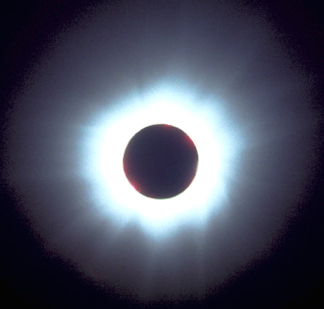Photographing the eclipse!
Do you really want to do it?
If you REALLY want to take eclipse pictures, look at this first! Photos like this require hundreds of pictures to be taken within the space of only
a couple of minutes - and then literally hundreds of hours of post-processing with the computer are necessary to achieve this
spectacular, world-class result. Miloslav is the undisputed king of this process, and all other mortals stand in awe of his
results. This is far outside the ability of most everyone on the planet, and if you fit this description, then
you're outside the scope of this site already! Otherwise, watch the eclipse and enjoy it! But if you want to give it a
shot, read on...
Remember that when you set up your equipment, you have to ensure that there is NEVER any chance AT ALL that anyone could possibly
look through an unfiltered camera lens at the Sun! If you're uncomfortable in any way with the technical aspects of filters,
f-stops, and quirks of more advanced photography, best to leave this area to the pros, and concentrate yourself on enjoying the
visuals of the eclipse. Burn images into your brain that will be better than photos, and will last the rest of your life!
Are you thinking of using a drone to photograph the crowd during the eclipse? Please see this link about
drone photography during an eclipse first!
If you'd like to take a closer look, instead...
 Eclipse2017.org is proud to recommend the Coronado line of solar viewing gear from Meade!
Eclipse2017.org is proud to recommend the Coronado line of solar viewing gear from Meade!
Great products from one of the world's leading telescope manufacturers!
These affordable scopes are ready to go for SAFE, direct solar viewing!
If you still want to try to do any kind of photography at all, you MUST do the following:
First, please read everything you can about the great eclipse photography that is being done.
For example, here is an eBook on eclipse photography written
by eclipse veteran Alan Dyer!
Then...
· DO NOT
USE A FLASH OF
ANY KIND! You will ruin the dark adaptation of everyone's eyes, and will spoil the show for them all!!
· Use a tripod if you have one - if you don't have one, buy one!
· Use a long enough lens that
you'll actually see something - standard point-and-shoot cameras will make the sun's image way too small. You will need at LEAST a 300mm focal length lens. (Test it out on
the full moon - which is about the same size as the sun - to see what your results will be.)
· Don't forget to take some grab
shots of the horizon and the crowd going nuts during totality.
· Set up a video camera (pointed at the people around you - NOT the sun!) and let
it run during totality, so you can always relive the foolish things you screamed during totality!
· Change ALL your equipment's batteries to fresh ones, 30 minutes before totality, so you
don't run out!
· Charge everything up the night before.
· DO NOT USE A FLASH
OF ANY KIND! You will ruin the dark adaptation of everyone's eyes, and will spoil the show for them all!!
· Remember that when totality hits, you will lose your ability to think clearly - keep it simple!
· Check out the exposures you should use from all the info on the sites listed below
· Bring small white washcloths to put over each of your cameras so they don't get hot from sitting in the direct sun (and wear a hat yourself!)
· Use the proper and correct solar filters (which you must have purchased especially for the purpose - if you don't have them, do NOT try to photograph the eclipse!)
before and after totality, and don't forget to remove them at second contact when totality starts! (attach them with strings so you can just flip them off the lens and they won't fly away)
· Pre-focus all your cameras on the full moon two weeks before the eclipse, and tape down the
lenses to their focused setting with duct tape.
· DO NOT
USE A FLASH OF ANY KIND! You will ruin the dark adaptation of everyone's eyes, and will spoil the show for them all!!
· Test everything beforehand until you can do it all in your sleep, and then test it again
· Think of anything that can go wrong, and plan for it
· Run through the entire
sequence of your actions beforehand, until it becomes
automatic. (Some people make a recording that they play during the eclipse, to remind them to "do this" and "do that",
at the right times.)
· Make a checklist of everything you'll need, and check that you've packed
everything before you leave home
· See what other people have done, and try to do better/different/your own thing
· Don't forget the binoculars - they are the best eclipse viewing tool! (Don't forget filters
for them, too - you MUST have special solar filters for the partial phases, or you CANNOT use the binocs!)
· Enjoy your own unique experience, and enjoy the fact that you've shared it with so
many new friends. Go around and thank them afterward.
· DO NOT USE A FLASH
OF ANY KIND! You will ruin the dark adaptation of everyone's eyes, and will spoil the show for them all!!
REMEMBER TO USE YOUR SOLAR FILTERS while the eclipse is not total, and DON'T use filters while the
eclipse is total. DURING TOTALITY ONLY, it is perfectly safe to look directly at the FULLY eclipsed
Sun! If you do not have proper filters for your camera equipment, then DO NOT attempt to take pictures of the
eclipse!
TURNING OFF YOUR FLASH
Even after having read all the above, we realize most of you will want to try to take a picture of what you're
seeing - eclipses are just that cool! So that you know,
here is a sample
of what a typical point-and-shoot picture of an eclipse will look like. We know, it isn't very exciting. We told
you so. But please, if you're going to take pictures like this, at least have the courtesy to turn your flash off.
Every camera has a way to do this, and they're all pretty similar:
1) FIND THE BUTTON THAT CONTROLS YOUR FLASH. This generally has a little "flash" icon on it:
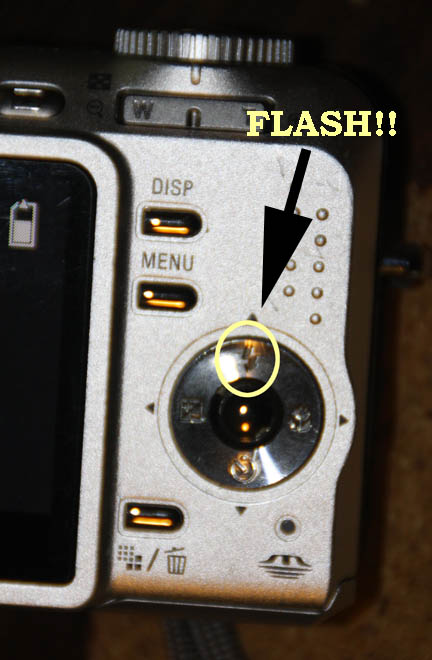
2) PRESS THIS BUTTON UNTIL IT SAYS 'FLASH OFF' (or some other similar phrase):
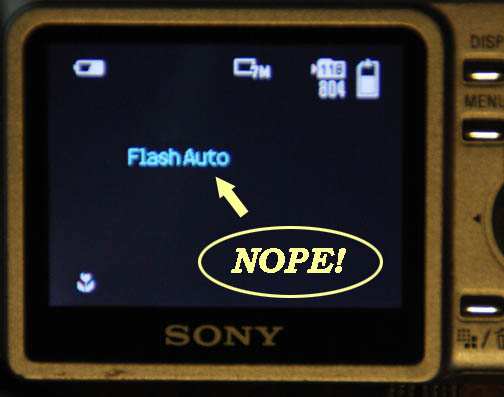 |
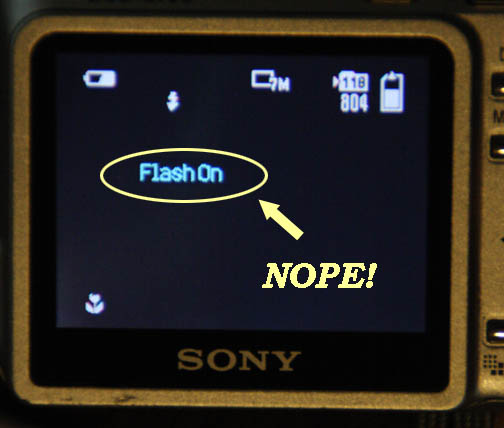 |
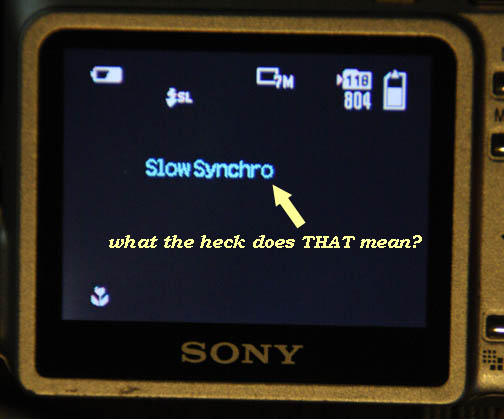 |
|
Not yet.....
|
AAAAAAAAAAGH! Especially not this!!!!!!!
|
We don't even know what this is supposed to do...
|
|
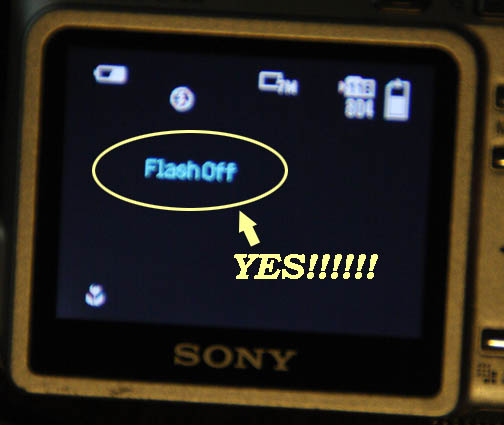
|
|
When it says this, you've got it!!!!!
|
Or, you can simply bypass all of this and use our old friend, electrical tape! See the instructions here:
|

|
|
Your primary tool (though scissors or a knife may come in handy to cut a suitable length of tape)
|
|
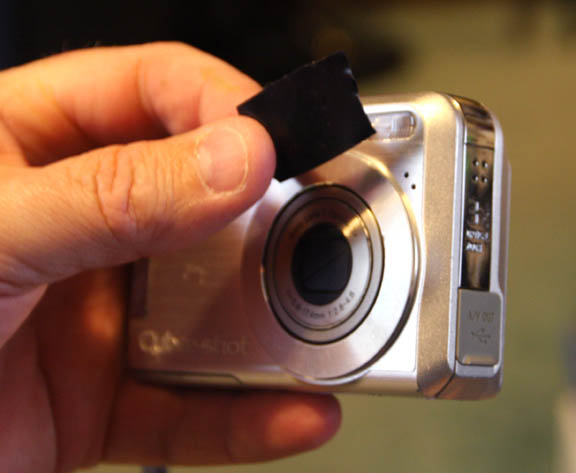
|
|
Applying the tool to your camera's offending member
|
|

|
|
The operation is a success! Your consideration of your fellow
eclipsers' eyes is much appreciated!
(Try to ensure [as we did not] that the tape is snug,
and that it covers ALL of the flash!!)
|
That will get you the ho-hum picture you saw
before. (
Here it
is again, in case you forgot.)
So, how do you get better pictures? Well,
you gotta have a long lens or telescope. Then, you have to
have a way to connect your camera to it. You also need a
good, stable tripod with a head that can be tilted to be able to
point up at the sun (some cannot, as most camera tripod
manufacturers don't account for the possibility that their
customers will want to point a camera up at the sky!), and you
need a cable release to fire your shutter. Plus you need to
have the right exposure settings to capture what you're interested
in: outer corona, inner corona, chromosphere, earthshine, prominences,
Baily's Beads - they all have different exposure settings that
work best. Here is a picture of what we would consider
to be a MINIMUM setup:

Here is a closeup of the setup:



